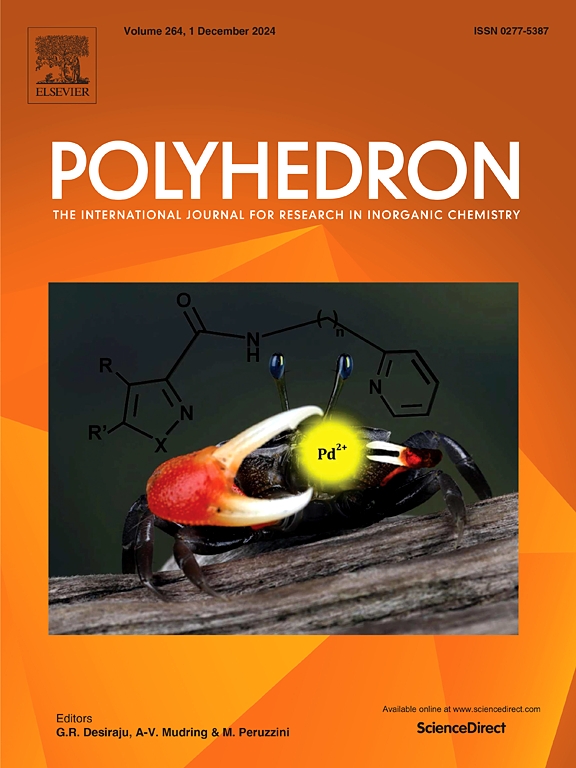啉对酞菁锌(II)超分子结构的控制
IF 2.4
3区 化学
Q2 CHEMISTRY, INORGANIC & NUCLEAR
引用次数: 0
摘要
研究了啉作为N-和o -给体(nhc4h60)对锌原子在ZnPc溶液中的配位的偏好。在此条件下,经N原子座标形成t形的ZnPc(Morph)配合物,在三斜体系的中心对称空间群中结晶为啉溶出物,ZnPc(Morph)·2(Morph)在不对称单元中有两个分子。两种独立的ZnPc(Morph)分子在酞菁大环的n4 -异吲哚平面外均表现出与Zn原子相似的构象,呈碟状。与母体ZnPc相比,ZnPc(Morph)·2(Morph)在晶体中的超分子排列表现为π···π相互作用的减少和体系间交叉的改善,并受溶剂啉分子的控制,从而提高了ZnPc(Morph)的溶解度,改善了其光物理和光化学性质。采用紫外可见光谱法研究了ZnPc(Morph)·2(Morph)建筑晶体在溶液中的聚集行为。此外,对溶液中的ZnPc(Morph)·2(Morph)晶体进行了紫外可见光谱表征,并对ZnPc(Morph)·2(Morph)固体样品进行了漫反射光谱(DSR)表征。ZnPc(Morph)·2(Morph)的DSR光谱表现出较宽的波段,并伴有轻微的蓝移,这可能是由于分子之间的接触比溶液中更紧密而产生了更大的激子耦合。为了支持和验证实验结果,进行了离散傅立叶变换和时变(TD)离散傅立叶变换计算。本文章由计算机程序翻译,如有差异,请以英文原文为准。

Control of the supramolecular structure of zinc(II) phthalocyanine by morpholine
The coordination preference of morpholine as an N- and O-donor ligand (NHC4H6O) for the coordination of zinc atom in ZnPc in solution was investigated. Under the conditions used, it has been shown that morpholine coordinates through the N atom to form a T-shaped ZnPc(Morph) complex, that crystallizes in the centrosymmetric space group of the triclinic system as morpholine disolvate, ZnPc(Morph)‧2(Morph) with two molecules in the asymmetric unit. Both independent ZnPc(Morph) molecules exhibit similar conformation with Zn atom out of the N4-isoindole plane of the phthalocyanine macrocycle that adopts a saucer-shaped. Supramolecular arrangement of the ZnPc(Morph)‧2(Morph) in crystal is characterized by a reduction of π···π interactions and an improvement in inter-system crossing in relation to parent ZnPc and is controlled by the solvent morpholine molecules, which results in increase its solubility and improved photophysical and photochemical properties. The aggregation behaviour of ZnPc(Morph)‧2(Morph) building crystals in solutions was investigated by UV–Vis spectroscopy. Besides, the UV–Vis spectroscopic characterization of the ZnPc(Morph)‧2(Morph) crystals in solutions, the diffuse reflectance spectroscopic (DSR) characterization on the solid sample of ZnPc(Morph)‧2(Morph) was performed. The DSR spectra of ZnPc(Morph)‧2(Morph) exhibit broad bands with a slight blue-shift that might be attributed to a larger exciton coupling resulting from closer contacts between the molecules than in solution. In order to support and verify the experimental results, the DFT and time-dependent (TD) DFT calculations were performed.
求助全文
通过发布文献求助,成功后即可免费获取论文全文。
去求助
来源期刊

Polyhedron
化学-晶体学
CiteScore
4.90
自引率
7.70%
发文量
515
审稿时长
2 months
期刊介绍:
Polyhedron publishes original, fundamental, experimental and theoretical work of the highest quality in all the major areas of inorganic chemistry. This includes synthetic chemistry, coordination chemistry, organometallic chemistry, bioinorganic chemistry, and solid-state and materials chemistry.
Papers should be significant pieces of work, and all new compounds must be appropriately characterized. The inclusion of single-crystal X-ray structural data is strongly encouraged, but papers reporting only the X-ray structure determination of a single compound will usually not be considered. Papers on solid-state or materials chemistry will be expected to have a significant molecular chemistry component (such as the synthesis and characterization of the molecular precursors and/or a systematic study of the use of different precursors or reaction conditions) or demonstrate a cutting-edge application (for example inorganic materials for energy applications). Papers dealing only with stability constants are not considered.
 求助内容:
求助内容: 应助结果提醒方式:
应助结果提醒方式:


